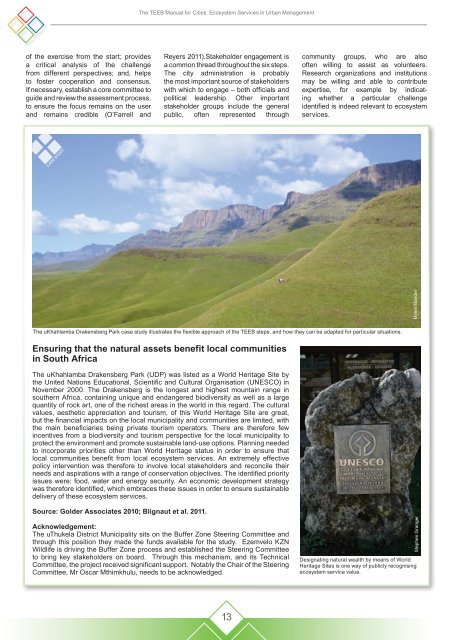TEEB Manual for Cities
TEEB Manual for Cities
TEEB Manual for Cities
You also want an ePaper? Increase the reach of your titles
YUMPU automatically turns print PDFs into web optimized ePapers that Google loves.
The <strong>TEEB</strong> <strong>Manual</strong> <strong>for</strong> <strong>Cities</strong>: Ecosystem Services in Urban Managementof the exercise from the start; providesa critical analysis of the challengefrom different perspectives; and, helpsto foster cooperation and consensus.If necessary, establish a core committee toguide and review the assessment process,to ensure the focus remains on the userand remains credible (O’Farrell andReyers 2011).Stakeholder engagement isa common thread throughout the six steps.The city administration is probablythe most important source of stakeholderswith which to engage – both officials andpolitical leadership. Other importantstakeholder groups include the generalpublic, often represented throughcommunity groups, who are alsooften willing to assist as volunteers.Research organizations and institutionsmay be willing and able to contributeexpertise, <strong>for</strong> example by indicatingwhether a particular challengeidentified is indeed relevant to ecosystemservices.The uKhahlamba Drakensberg Park case study illustrates the flexible approach of the <strong>TEEB</strong> steps, and how they can be adapted <strong>for</strong> particular situations.Ensuring that the natural assets benefit local communitiesin South AfricaThe uKhahlamba Drakensberg Park (UDP) was listed as a World Heritage Site bythe United Nations Educational, Scientific and Cultural Organisation (UNESCO) inNovember 2000. The Drakensberg is the longest and highest mountain range insouthern Africa, containing unique and endangered biodiversity as well as a largequantity of rock art, one of the richest areas in the world in this regard. The culturalvalues, aesthetic appreciation and tourism, of this World Heritage Site are great,but the financial impacts on the local municipality and communities are limited, withthe main beneficiaries being private tourism operators. There are there<strong>for</strong>e fewincentives from a biodiversity and tourism perspective <strong>for</strong> the local municipality toprotect the environment and promote sustainable land-use options. Planning neededto incorporate priorities other than World Heritage status in order to ensure thatlocal communities benefit from local ecosystem services. An extremely effectivepolicy intervention was there<strong>for</strong>e to involve local stakeholders and reconcile theirneeds and aspirations with a range of conservation objectives. The identified priorityissues were: food, water and energy security. An economic development strategywas there<strong>for</strong>e identified, which embraces these issues in order to ensure sustainabledelivery of these ecosystem services.Source: Golder Associates 2010; Blignaut et al. 2011.Acknowledgement:The uThukela District Municipality sits on the Buffer Zone Steering Committee andthrough this position they made the funds available <strong>for</strong> the study. Ezemvelo KZNWildlife is driving the Buffer Zone process and established the Steering Committeeto bring key stakeholders on board. Through this mechanism, and its TechnicalCommittee, the project received significant support. Notably the Chair of the SteeringCommittee, Mr Oscar Mthimkhulu, needs to be acknowledged.Designating natural wealth by means of WorldHeritage Sites is one way of publicly recognisingecosystem service value.Stephen Granger Myles Mander13
















